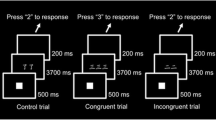Abstract
Hyperactive and normal children were given a test of selective attention (Stroop test) and a neurocognitive test sensitive to a functional deficit of prefrontal cortex (Wisconsin Card Sorting Test). Hyperactive children showed significant deficits on both measures. After a year of psychostimulant medication, the hyperactive children all showed clinical and neurocognitive improvement, but continued to show a selective attention deficit compared with normal children. The results indicate a dissociation between the cognitive processes measured by the Wisconsin test and selective attention as measured by the Stroop, and that the selective attention deficit is more resistant to psychostimulant intervention.
Similar content being viewed by others
References
Posner, MI and Boies SJ: Components of attention.Psychological Reports 78: 391–408, 1974.
Taylor, EA: Childhood hyperactivity.British Journal of Psychiatry, 149: 562–573. 1986.
Douglas, VI: Stop, look, and listen: The problem of sustained attention and impulse control in hyperactive and normal children.Canadian Journal of Behavioral Science 4: 259–282, 1972.
Borcherding, B, Thompson K, Kruesi M, Bartko J, Rapoport JL, & Weingartner H: Automatic and effortful processing in attention deficit/hyperactivity disorder.J of Abn Child Psychology 16: 333–345, 1988.
Rosenthal RH & Allen TW: An examination of attention, arousal, and learning dysfunctions of hyperkinetic children.Psychol Bull 85: 689–715, 1978.
Ross, AO:Psychological Aspects of Learning Disabilities and Reading Disorders. New York: McGraw-Hill, 1976.
Douglas VI. (1983) Attention and cognitive problems. InDevelopmental Neuropsychiatry ed. Rutter, M. New York: Guilford Press, 1983.
Stroop JR: Studies of interference in serial verbal reactionsJ Exp Psychol 18: 643–662, 1935.
Laplante L.: Software survey section: Stroop Colored word interference test.J Psych Res 2: 1–111, 1988.
Drouin P: Performance attentionnelle, mécanismes d'inhibition et rôle du cortex frontal dans le trouble d'attention et d'hyperactivité chez l'enfant. Thèse de Maîtrise, Université Laval, 1990.
Dyckman, RA, Ackerman PT, Clements S, Peters JE: Specific learning disabilities: An attentional deficit syndrome. InProgress in Learning Disabilities (vol 2) ed. Mykelbust HR. New York: Grune & Stratton. 1971.
Wender P:Minimal Brain Dysfunction in Children. New York: Wiley-Interscience, 1971.
Zametkin AJ, Rapoport JL: Neurobiology of attention deficit disorder with hyper-activity: Where have we come in 50 years?J Am Acad Child Adol Pschiat 26: 676–686, 1987.
Chelune GJ, Ferguson W, Koon R, Dickey TO: Frontal lobe disinhibition in attention deficit disorder.Child Psychiat Hum Devel 16: 221–234, 1986.
Abikoff H, Gittelman R: The normalizing effects of methylphenidate on the classroom behavior of ADDH children.J Abn Child Psychol 13: 33–44 1985.
Ross AO, Pelham WE: Child psychopathology.Ann Rev Psychol, 32: 243–278, 1981.
Whalen C, Henker B, Hinshaw S: Cognitive-behavioral therapies for hyperactive children: premises, problems, and prospects.J Abn Child Psychol 13: 391–410, 1985.
Safer DJ, Allen RP:Hyperactive Children: Diagnosis and Management Baltimore: Universal Park, 1976.
Barkley RA, Cunningham CF: Do stimulant drugs improve the academic performance of hyperkinetic children? A review of outcome studies.Clinical Pediatrics 17: 85–92, 1978.
Loney J: Hyperkinesis comes of age; What do we know, where should we go?Am J of Orthopsychiat, 50: 28–42, 1980.
Rie ED, Rie HE: Recall retention and Ritalin.J Consult Clin Psychol 44: 250–260, 1977.
Weiss G: Controversial issues of the pharmacotherapy of the hyperactive child.Can J Psychiat, 149: 562–573, 1981.
Ross LA, Ross SA:Hyperactivity: Current Issues, Research, and Theory (2nd ed.), New York: Wiley, 1982.
Weiss G, Kruger E, Danielson V, Elman, J: Effects of long-term treatment of hyper-active children with methylphenidate.Can Medical Ass J, 112: 159–165 1975.
Whalen CK, Henker B: (1980). The social ecology of psychostimulant treatment: A model for conceptual and empirical analysis. InHyperactive Children: The Social Ecology of Identification and Treatment eds. Whalen, C.K. & henker, B. New York: Academic Press, 1980.
Abikoff H: Efficacy of cognitive training interventions in hyperactive children: a critical review.Clin Psychol Rev, 5: 479–512, 1985.
Milner B: Effects of different, brain lesions on card sorting: The role of the frontal lobes. Arch Neurol, 9: 90–100, 1963.
Everett J, Laplante L, Thomas J: The selective attention deficit in schizophrenics: Limited resources or cognitive fatigue?J Nerv Mental Dis, 177: 735–738, 1989.
Weingartner H, Rapoport JL, Buchsbaum MS, Bunney WE, Ebert MH, Mikkelsen EJ, Caine ED: Cognitive processes in normal and hyperactive children and their response to amphetamine treatment.J Abn Psychol, 89: 25–37, 1980.
Brown RT, Borden KA, Wynne ME, Schleser R, Clingerman SR: Methylphenidate and cognitive therapy with ADD children: a methodological reconsideration.J Abn Child Psychol, 14: 481–497, 1986.
Kendall PC, Finch AJ: (1978). A cognitive-behavioral treatment for impulse control: A case study.J Consult Clin Psychol, 44: 852–857, 1978.
Author information
Authors and Affiliations
Rights and permissions
About this article
Cite this article
Everett, J., Thomas, J., Cote, F. et al. Cognitive effects of psychostimulant medication in hyperactive children. Child Psych Hum Dev 22, 79–87 (1991). https://doi.org/10.1007/BF00707786
Received:
Revised:
Accepted:
Issue Date:
DOI: https://doi.org/10.1007/BF00707786




